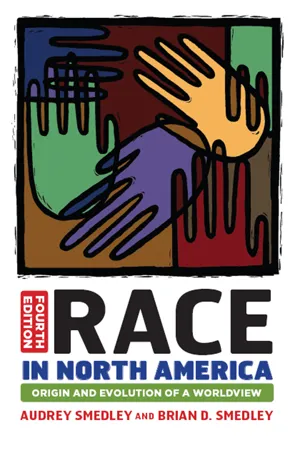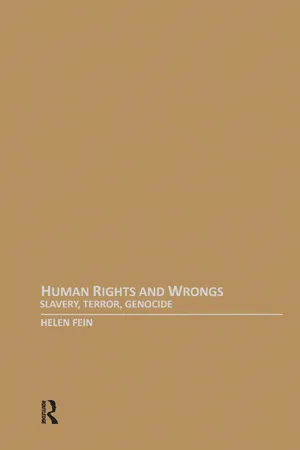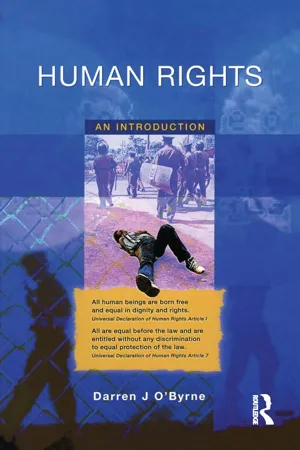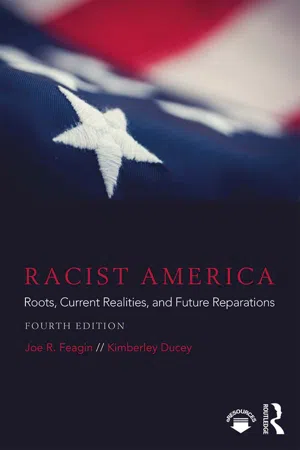History
History of Slavery
The history of slavery spans thousands of years and has been a widespread practice across various cultures and civilizations. It involves the ownership and exploitation of individuals as forced laborers, often under brutal and inhumane conditions. Slavery has had a profound impact on shaping societies, economies, and the course of human history.
Written by Perlego with AI-assistance
Related key terms
Related key terms
1 of 4
Related key terms
1 of 3
7 Key excerpts on "History of Slavery"
- eBook - ePub
Modern Slavery and Bonded Labour in South Asia
A Human Rights-Based Approach
- Elena Samonova(Author)
- 2019(Publication Date)
- Routledge(Publisher)
1 Slavery and bonded labourA problem of definition
Definitions of slavery
Slavery is one of history’s oldest social institutions. The first legal documentation of the sale of slaves found in Mesopotamia is dated 2300 bc (see also Drescher, 2010; Olusoga, 2018). Various international conventions and covenants declare slavery as a grave violation of human rights and even as a crime against humanity (Gallagher, 2008; Miers, 2008; Rassam, 1998; van den Anker, 2004). However, despite these prohibitions the practices of slavery have not yet disappeared from the Earth. In 2016 the International Labour Organization (ILO) claimed that in the past five years 89 million people have experienced some form of slavery for periods ranging from a few weeks to five years (ILO, 2017, p. 10). In 2017 alone at least 40.3 million people were ensnared in various forms of modern slavery.1 However, what does it mean to be enslaved? How can we decide whether a person is trapped in slavery or just suffers from unfair and exploitative labour conditions?Defining slavery is not an easy task, but doing so has crucial implications for the process of the abolition of slavery. As Androff (2010) argued, if slavery is defined too narrowly, some slavery practices may not be considered during policy implementation and some people at risk will be excluded from such policy, yet if slavery is defined too widely, the definition could become meaningless (p. 211). In the Western tradition, slavery is often in direct opposition to freedom: “whereas a ‘free’ individual enjoyed basic rights of citizenship, choice of occupation and lifestyle … a slave was a chattel with hereditary status” (Campbell, 2005, p. viii). Such an understanding of slavery is mostly based on the experiences of slavery in the Americas, where the slaves were used in plantation work and were seen as private property that could be bought and sold freely. However, this is only one extreme form of slavery; numerous other types of slavery exist in the modern world. - eBook - ePub
Race in North America
Origin and Evolution of a Worldview
- Audrey Smedley(Author)
- 2018(Publication Date)
- Routledge(Publisher)
This research has shown, however, that the diversity of forms of servitude and the customs associated with them have been considerable; a wide range of customs, practices, beliefs, norms, and values have been subsumed under the rubric of “slavery.” Sometimes the dissimilarities between societies have been so great that they inhibit making generalizations acceptable to all scholars. Different scholars emphasize differing aspects of slavery, and they often disagree on how to translate terms in other languages into concepts meaningful for comparative study. The result is that there is only limited and somewhat tentative agreement on the empirical dimensions of slavery contrasted with other forms of servitude. 7 Nevertheless, slavery has generally been defined as an institution in which some persons are legally owned by other persons just as a piece of property is owned. The slave exercises no will of his or her own, theoretically, but submits to the authority and domination of the master. Customs and laws in slaveowning societies permit a slave to be bought, sold, given away, inherited, bequeathed, used to pay debts, or used in any other way that personal property can be used. Thus the essential quality of slavery everywhere has been that an individual is defined legally as a thing, a piece of property owned by another, and physical force or some other form of coercion is the chief mechanism for maintaining this notion. 8 The power of the master-owner over the slave may vary in time and space, but it has always been one constant, and usually inviolable, fact. But the slave is also a human being, with all the attributes of consciousness, sensitivity, and thought that characterize free persons, and this is where the fundamental contradiction unfolds - eBook - ePub
Human Rights and Wrongs
Slavery, Terror, Genocide
- Helen Fein(Author)
- 2015(Publication Date)
- Routledge(Publisher)
2 Twentieth-Century Slavery within the State Slavery is the permanent, violent domination of natally alienated and generally dishonored persons…. We may summarize the two modes of representing the social death that was slavery by saying that in the intrusive mode the slave was conceived of as someone who did not belong because he was an outsider, while in the extrusive mode the slave became an outsider because he did not or no longer belonged. —Orlando Patterson, Slavery and Social Death, 1982 It is widely believed that slavery ended in the nineteenth century with the cessation of the transatlantic slave trade from Africa to North America, but it continues in other guises. This chapter focuses on slavery within the state and the next chapter looks at global slavery and trafficking for the sex trade among countries. One must ask: What constitutes slavery fundamentally? Box 2.1 cites legal definitions of both slavery and trafficking. The reader might note the broadening of the practices cited from 1956 to 2000 beyond the fact of ownership and the stress on motives of slaveholders and traffickers. Chattel slavery—holding slaves as movable property that can be bought or sold—is one of many forms of slavery, which include penal enslavement, state slave labor, and debt bondage. Slavery has an ancient history, as do other exploitative forms of labor. The addition in the 1956 Supplementary Convention of “the sale or involuntary transfer of women for marriage ‘without the right to refuse’” is consistent with the implication of autonomy in the sixth right in our list of life integrity rights (see table 1.1, ch. 1), “the right to procreate and cohabit with family.” The 1956 Convention focuses on slave traders, owners, and family members as violators. Violations by the latter include involuntary transfer of women in marriage for money, involuntary transfer of a wife to another person, and inheritance of the widow - eBook - ePub
Human Rights
An Introduction
- Darren O'Byrne(Author)
- 2014(Publication Date)
- Routledge(Publisher)
Chapter Eight Slavery DOI: 10.4324/9781315837475-9No one shall be held in slavery or servitude; slavery and the slave trade shall be prohibited in all their forms.Universal Declaration of Human Rights, Article 4What is slavery?
Slavery, which throughout history has taken many forms, might be described as the formal (but not always legal) denial to individuals or groups of a particular freedom, to have control over their own lives. Yet even this simple attempt at a definition is unsatisfactory. It raises moral questions as well as intellectual ones. What, exactly, would such a freedom entail? Why should we treat it as a right ? And if we are to approach slavery from the perspective of a social scientist, what exactly should we focus our attention on? We might, for example, concern ourselves with any number of the following: slavery as an institution and its various forms; the relationship between slavery and ‘race’; the experience of slavery; the conditions which make slavery possible and/or profitable; slavery as a social relationship between master and slave; the relationship between slavery and capitalism, and the position of slaves within the class structure. Each of these raises sociological questions.1 We would, then, agree with Orlando Patterson, who has described slavery as ‘a remarkable case study of the nature of social values and of social change … [and] … the fundamental sociological problem of social order and control’.2Geoffrey de Ste. Croix,3 who usually talks about ‘unfree labour’ as a general category, makes the distinction within this between chattel slavery, debt bondage, and serfdom - eBook - ePub
On Human Bondage
After Slavery and Social Death
- John Bodel, Walter Scheidel(Authors)
- 2016(Publication Date)
- Wiley-Blackwell(Publisher)
Failure to meet the stated criteria of definition results in exclusion from the category. Historians, by contrast, are drawn to situational contingencies and distinctive peculiarities of behavior or practice in specific cultures, and their approach to understanding institutions is oriented toward investigating change over time. Joseph Miller has recently called for a more contextualized approach to the study of slavery world‐wide, one less centered on the dyadic relationship of master and slave (whether the relationship is conceived of primarily as one of domination or as a matter of property) and more attentive to the contexts that shaped the behavior of slavers and the enslaved alike; slavery, in his view, is best approached as a set of historicized human strategies rather than an abstract institution (Miller 2012: 1–35). 11 Our contributors set out to assess the cogency of Patterson’s analysis, and more particularly his definition of slavery on its own terms within their areas of specialist expertise. In doing so, many have engaged in the new historicist approach to slavery advocated by Miller, with the result that slavery emerges from these pages in all its diversity as a variable and evolutionary practice. Other essays aimed more squarely at the conceptual underpinnings of Patterson’s elegant formulations have prompted refinement and elaboration of the core terms of definition. On no topic addressed has the last word been said. Thirty‐five years after its publication, Patterson’s remarkable study continues to inspire and to provoke debate. References Allain, J. and K. Bales. 2012. “Slavery and its definition.” Global Dialogue 14: 1–15. Bales, K. 2012. “Response to Professor Orlando Patterson.” In J. Allain (ed.), The Legal Understanding of Slavery, 360–372. Oxford. Berlin, I. 2010. The Making of African America: The Four Great Migrations. New York. Brown, V. 2009 - eBook - ePub
Racist America
Roots, Current Realities, and Future Reparations
- Joe R. Feagin, Kimberley Ducey(Authors)
- 2018(Publication Date)
- Routledge(Publisher)
Chapter 4 , pp. 112–113) and the extraordinarily brutal, often sexualized attacks on black men in thousands of Jim Crow lynchings and other violent attacks on black men over the last century and a half.A Distinctive Form of Human Slavery
In the Americas the Europeans applied slavery, as Du Bois reminds us, “on a scale and with an elaborateness of detail of which no former world ever dreamed. The imperial width of the thing—the heaven-defying audacity—makes its modern newness.”36 Unlike Roman slaves, North American slaves were generally forbidden by law to read or write. Those enslaved could “make no contracts;… hold no property;… could not hire out;… could not legally marry… could not appeal from their master.”37Even the English language became an important weapon for subordinating enslaved Africans. The latter were from many different societies, but were forced to learn the language of their oppressors. Voluntary immigrants to the U.S. have generally been allowed to retain more of their home languages and cultures. In the destruction of African languages and their replacement by English we see how extensive the system of racial oppression is. Enforced adaptation to English not only marked the movement of early English colonizers across the lands of conquest, but also marks today—such as in attacks on Spanish or Ebonics—similar attempts to maintain white cultural dominance over those who are racially subordinated.38Note too that numerous African societies paid a heavy price. For centuries many of the African continent’s young people were ripped from its shores, thereby greatly damaging its future development. Tens of millions were enslaved or died in the Atlantic slave trade. Over time, this trade in human beings had serious negative effects on institutions in Africa, a destruction that facilitated later European exploitation and colonization of that continent. Any serious understanding of the development of European wealth must center on African colonialism, for the labor and mineral resources of Africans were taken to help create large-scale European prosperity.39 - eBook - ePub
Slavery
A Problem in American Institutional and Intellectual Life
- Stanley M. Elkins(Author)
- 2013(Publication Date)
- University of Chicago Press(Publisher)
Institutions and the Law of Slavery1INSTITUTIONAL BREAKDOWN IN AN AGE OF EXPANSIONIt was inherent in the state of sensibility which Western civilization had attained by the nineteenth century that slavery, involving the most basic values of humanity, should at that time become morally absorbing to both Europeans and Americans. Englishmen, Frenchmen, Spaniards, and Portuguese each responded to the oppressive subject at various levels of intensity in thought and action; out of their complex experience each could focus upon slavery a variety of resources in order that they might judge its evils, mitigate its abuses, and finally abolish it altogether.1 There is a certain sense in which the same might be said of the Americans. Yet the simple and harsh moral purity of our own antislavery movement, from the 1830’s on, gave it a quality which set it apart from the others. The theory of society which was its backdrop, the intellectual expressions upon which it drew, the slogans which it sent to the market place, the schemes for practical action which it evolved—every phase of the movement combined to produce in our abolitionists that peculiar quality of abstraction which was, and has remained, uniquely American. For them, the question was all moral; it must be contemplated in terms untouched by expediency, untarnished by society’s organic compromises, uncorrupted even by society itself. It was a problem of conscience which by mid-century would fasten itself in one form or another, and in varying degrees, upon men’s feelings everywhere.But while our thinkers and reformers considered the issue in such abstract purity, in such simple grandeur, there was, in principle if not in fact, an alternative philosophical mode. Slavery might have been approached not as a problem in pure morality but as a question of institutional arrangements—a question of those institutions which make the crucial difference in men’s relationships with one another, of those arrangements whereby even so theoretically simple a connection as that between master and slave might take any of a dozen forms among which the sharpest and finest of moral distinctions might be made. This approach was of course never taken, and to expect it of nineteenth-century Americans would be to make impossible demands upon their experience. It is, however, still of interest to ask why this should be so. Why should the American of, say, 1830 have been so insensitive to institutions and their function?
Index pages curate the most relevant extracts from our library of academic textbooks. They’ve been created using an in-house natural language model (NLM), each adding context and meaning to key research topics.
Explore more topic indexes
Explore more topic indexes
1 of 6
Explore more topic indexes
1 of 4






